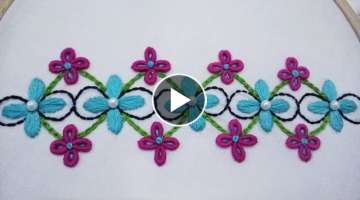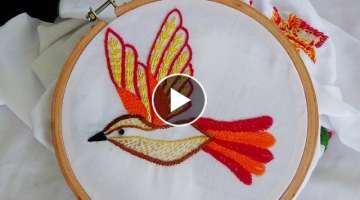Hand Embroidery Designs | Japanese stitch | Stitch and Flower-142
Hand Embroidery Designs | Japanese stitch | Stitch and Flower-142 https://youtu.be/SNLSRBvX9DQ
Store: http://handembstitch.blogspot.com/p/embroidery-store.html
Options for embroidery designs are limitless. The whole world of pictorial art awaits the embroiderer, who may choose pre-printed illustrations and painted backgrounds, or select artwork fro another medium to stitch. For those who have illustration talent, embroidery offers the same creative possibilities as painting. Even simple line drawings become gorgeous works of art when filled in with beautiful, colorful threads.
Pre-Printed Outlines
Fabric with printed design outlines have been popular for a century or more, and they've served as many a young stitcher's introduction to working with a needle and thread. Often they're sold in kits that contain all the necessary threads as well as a picture with a key to indicate thread colors and specific stitches.
Pre-Printed Fabric
This method offers the stitcher painted color blocks for the background of the design; only the actual foreground motifs need be stitched (outlines are provided), not the entire fabric surface. These are usually sold in kits which come with illustrated keys to indicate the thread colors and type of stitches to use.
Stamped Cross Stitch
Although we usually think of cross stitch as a counted thread technique, pre-printed cross stitch designs are available that indicate cross stitches on a ground fabric. Because it is impossible for the printer to line up the stitches with the grain of the fabric perfectly, the stitcher follows the stamping, not the fabric weave, so the tecnique falls under the category of embroidery instead of counted thread.
Pre-printed designs on fabric include designs that require only embroidery accents, designs with painted backgrounds only, and designs with outlines only.
Designs You Transfer Onto Fabric
These methods offer the option of combining your choice of fabric, thread colors and embroidery design.
Iron On Transfer Designs
This method is similar to pre-printed outlines except you iron the design onto your choice of fabric. Many iron-on transfers are available in a wide range of styles to suit contemporary tastes. A revival of interest in old embroidery designs has sparked publishers to re-issue transfers for popular subjects.
Transfer Pens And Pencils
These inexpensive tools enable you either to trace a design onto paper, then iron the design onto your fabric (yielding a mirror image), or to draw directly onto your fabric. Some are designed to wash out of the fabric after stitching. Others leave marks which intentionally fade after a brief period of time (from eight to 48 hours) to use when you know you will have sufficient time to complete the stitching. Manufacturers offer various colors of pencils and pens to enable you to transfer onto both light and dark fabrics.
Direct Tracing
If the design fabric is light in color and weight, it's often possible to place the fabric over the design outline and draw directly onto the fabric, using a fabric marking pen. The marks then wash out when the stitching is completed. Always test wash the fabric before transferring.
Dressmaker's Carbon
This allows you to transfer a mirror image of a design onto fabric.
Pricking and Pouncing
This is one of the oldest methods of design transfer, and requires a sharp needle (the eye end may be inserted into a wine cork to make it easier to handle) or tracing wheel to pierce the design paper and either pounce powder, tailor's chalk, r a fabric marking pen. This method is popular with quilters, so you can find supplies for this method at quilting shops.
Article Source: [http://EzineArticles.com/?Hand-Embroidery-Designs---Everything-You-Ever-Wanted-to-Know&id=4358083] Hand Embroidery Designs - Everything You Ever Wanted to Know
Noel by Audionautix is licensed under a Creative Commons Attribution license (https://creativecommons.org/licenses/by/4.0/)
Artist: http://audionautix.com/

Video
Share
Facebook Comments































